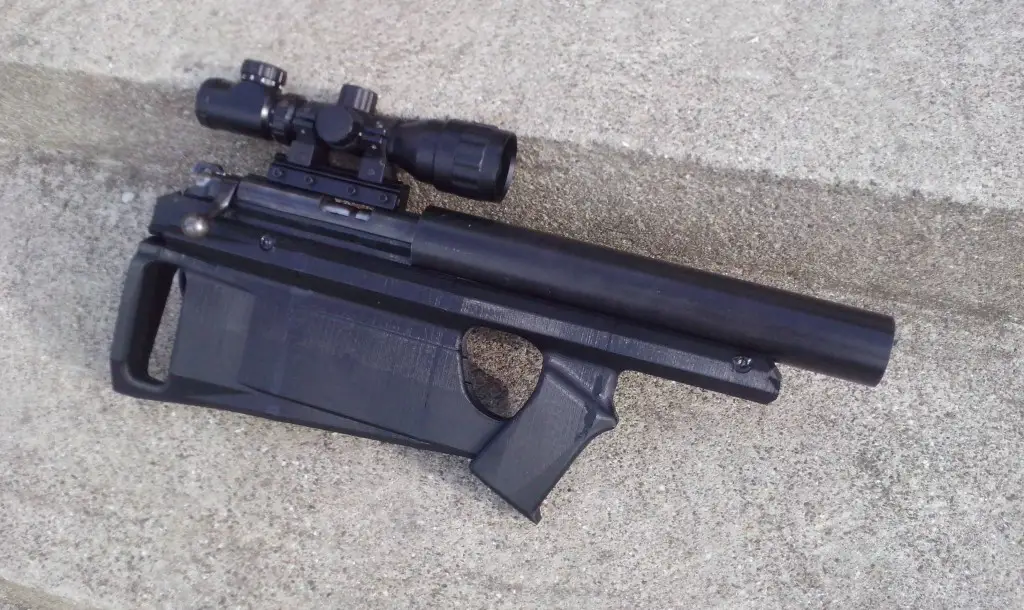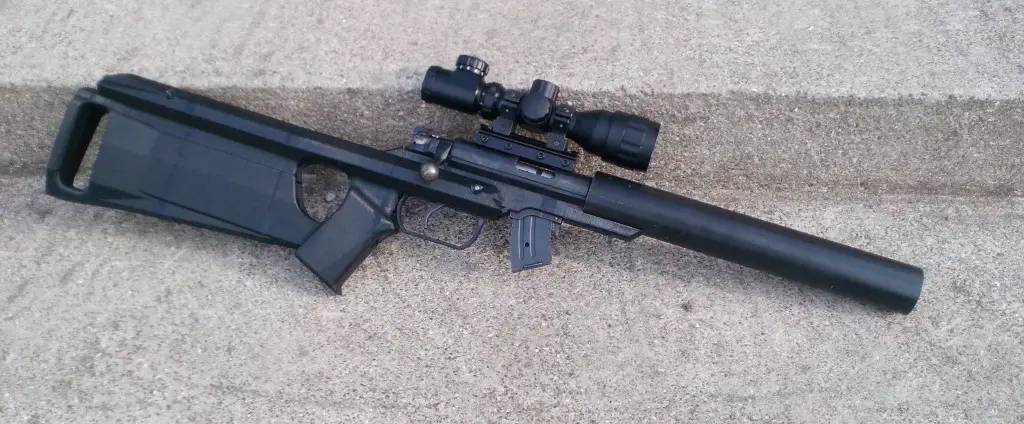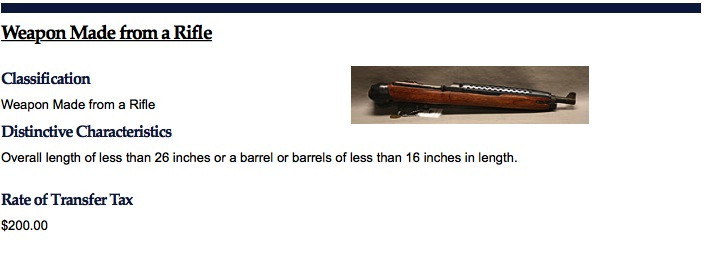We saw this very cool .22 rifle on Reddit and Imgur — but the story behind the rifle was even more interesting, to us, because it’s a tale of human adaptation to that most inhuman of human adaptations, bureaucracy.
Every jurisdiction — nation, state, province, municipality — has more or less authority to regulate guns, and that means that there’s a lot of variation worldwide. And gun enthusiasts in those countries produce innovations, sometimes, that are driven by the peculiar aspects of their national laws. Take this rimfire bolt-action from the island paradise of New Zealand (these pictures do embiggen greatly if clicked:
OK, that’s the transport mode, with the stock collapsed. Here’s what it looks like, stock extended.
Pretty cool? Want one? Er, wait, while we digress into international gun law.
Many nations try to ban all but hunting guns, or ban handguns. (Handguns tend to be preferred by criminals, due to their concealability). In nations that ban or highly restrict handguns, there tend to be restrictions on minimum size of rifles and shotguns. The New Zealand restrictions on what is an A-License Category firearm drove the development of the rifle you see here.
The US NFA as an Example
The US has an equivalent law, and it, too, originated as an attempt to ban or highly restrict handguns. The original intent of the sponsors of the National Firearms Act of 1934 was to ban (or technically, restrict, but de facto ban with a Pigovian Tax) pistols and revolvers, as well as machine guns, silencers, and cannons. Their lawyers told them they could not structure a ban as a ban, but could slide it through as a tax measure. But their vote-counters told the New York, Chicago and Boston liberals behind the law that they’d never sell a pistol ban to representatives and senators from the West or South.
So the law passed with the machine-gun and silencer restrictions, and restrictions on short-barrel rifles and short-barrel shotguns which were originally meant to prevent outflanking the pistol ban that was deleted from the bill. (The secondary purpose of the law was to ensure that the agents of the famously corrupt Prohibition Bureau didn’t lose their government jobs, as numbers of them had some connection to a politician).
Most every American gunnie can quote you the barrel length restrictions in the NFA. Rifles must have barrels of 16″; shotguns, 18″. But there are also overall length restrictions of 26″ for both weapons. This technical distinction means it is possible to have a weapon with a perfectly legal barrel length, but given a pistol-grip or other short stock, or a bullpup configuration, the weapon is illegal. (What does ATF call a weapon like that, that cannot be a “short-barreled rifle” or “short-barreled shotgun” because, well, the barrel isn’t legally “short”? The term of art is “weapon made from a rifle”…
…or “weapon made from a shotgun.”
Legally, the difference between SBR or SBS and “weapon made from” in the USA is not that great. Both a short-barreled long-gun, and a “weapon made from” a long gun, require a registration under NFA and approval and tax paid ($200) prior to manufacture. Possession of one without your legal and tax ducks in a row en avant is a major Federal felony with a decade in prison as the “prize.”
Of course, that’s US law, and New Zealand has its own.
The New Zealand Law and Its Variance from the US NFA
New Zealand is a different country, and her representatives have written, not surprisingly, entirely different laws. By and large, Kiwi laws are restrictive, comparable not to the USA in general but perhaps to the USA’s more restrictive jurisdictions, such as Massachusetts or Illinois. Firearms of non-sporting types must be registered, and owners must be approved by the police as having a “good reason” to own that type of weapon. Self-defense is explicitly excluded as a reason.
Like there used to be in Massachusetts, there are “classes” of license, although in NZ they get quite complex:
- Class A or “standard” license: sporting shotguns and rifles, and air guns.
- Endorsement B: pistols for target shooting, which may be used at police-approved target shooting clubs, only
- Endorsement C: collect pistols or “restricted” weapons, but not necessarily to shoot them
- Endorsement E: to own and fire the dreaded “assault weapons,” which are called “Military Standard Semi Automatic (MSSA)” in Kiwi law.
An interesting peculiarity of New Zealand law is that you must be licensed to shoot these weapons even if you do not own them. Apart from some provisions for rentals by professionals, an unlicensed person may fire only Class A, sporting, arms, under the direct supervision of a licensee
Gun licenses are managed by the police. Their website says:
Someone will arrange to visit you. They will interview you and check your firearms security arrangements. They will arrange to interview your referees.
You will have difficulty being deemed ‘fit and proper’ to possess or use firearms if you have:
– a history of violence
– repeated involvement with drugs
– been irresponsible with alcohol
– a personal or social relationship with people deemed to be unsuitable to be given access to firearms
– indicated an intent to use a firearm for self-defence.
There are some bizarre requirements. For instance, if you don’t keep your firearms at home, it doesn’t matter- you still have to install a security system. (Maybe some top NZ rozzer is getting a kickback from the alarm manufacturer). But it’s their country, they set their own rules.
What the Kiwi Inventor Did and Why it’s Cool
So, our New Zealander wanted to update and improve a fairly conventional Norinco .22 sporting rifle, whilst keeping it legal on a standard “A” license. He envisioned this:
With a sliding stock to make it even more compact. (The suppressor is legal and unregulated, as near as we can tell, in his island nation. Other country, other rules). But the NZ equivalent of the US SBR law means a gun ceases to be sporting (which makes it, what? “Not cricket?”) if it’s shorter than 762 mm.
No matter how inept you are with the metric system, if you’re a gun guy who knows that .30 caliber is 7.62 mm, you ought to be able to figure out that the customizer of this gun, who goes by the Reddit handle CPT Tooks, needed to keep his gun 30 inches long (gee, even longer than our silly SBR law). But the New Zealand law has one marked superiority over the US equivalent — if the weapon can’t be fired in its retracted mode, it is only measured in the mode it can be shot in. As you can see, Tooks’s stock guards the trigger when forward. He says:
I have been working on this one for a while now. Its a suppressed .22lr with a collapsible stock. It started life as a full length Norinco JW15. My goal was to create a stock that could be as compact as possible that would not infringe the New Zealand A-Cat. rifle length law when it is folded down. As you can see when the rifle is less than legal length for a rifle in NZ (762mm) you can no longer engage the trigger. length collapsed = 470mm
That’s 18.5 inches, for all of us bitter clingers to the measurement standards of the Laws of Aethelberht.
Here are some more of Tooks’s comments, edited out of the relevant Reddit thread:
I modeled the stock in CAD (Solidworks) and printed it on my 3D Printer. So I just made the stock to fit the Norinco’s action. Cut the barrel down to 7 inches, re-crowned it and made the suppressor for it. Done.
NZ has no limitations on short rifle barrels, or suppressors. He does not seem to have made the suppressor on the 3D printer, but if you look closely at the pictures of the stock, the telltale lines of additive manufacturing are given away.
I print suppressors on .22lr, .17hmr and .22mag- they are pretty big like the one on this gun but they do work great!. (ABS- If done right its easily strong enough for rim fire). I have put 500+ rounds through my mk1 model with no failure. I live in New Zealand so its not illegal to make suppressors.
He is still responding in the thread.
In the USA it’s not illegal to make suppressors, but it’s restricted. Tooks is not averse to releasing his designs, but wants to do it in a manner that will get him paid, rather than just dumping them on the net.
Here in the USA, someone would have to convert his stock design to a weapon which is available here, as Norinco imports have been banned since 1989. The ATF interprets the SBR law differently, depending on whether the stock is folding or detachable. If a rifle has a folding stock, it is measured in the extended position, on the presumption that it is meant to be fired that way, even if it can be fired folded. That’s why an Uzi carbine with a metal stock and a 16″ barrel is a Title I firearm, and an Uzi with the same barrel and a detachable wood stock is not. (It is a Weapon Made From a Rifle). Both are about 24 ½” long. Likewise, if you rig the Uzi’s metal stock to be removable, it is no longer a Title I firearm but a Title II NFA arm.
Some states are weird about this, also. Michigan considers rifles that are operable when folded to be SBRs banned under state law if under 26″ (which includes all those Uzis). Folding stock rifles that fold to between 26″ and 30″ and are operable folded, like the AK or most folding M1 Carbines, are classed as “pistols” in that state, and must be registered if you are a resident… but in an unintended consequence of the attorney-general ruling that created this law, are legal to carry loaded, concealed, or in a car, with a pistol license from any recognized jurisdiction! Yes, in Michigan, you can’t carry a fixed-stock AR or AK loaded in your car, but if you can fold it to between 26″ and 30″ you can call it a pistol and be armed to survive in Detroit.

Kevin was a former Special Forces weapons man (MOS 18B, before the 18 series, 11B with Skill Qualification Indicator of S). His focus was on weapons: their history, effects and employment. He started WeaponsMan.com in 2011 and operated it until he passed away in 2017. His work is being preserved here at the request of his family.







7 thoughts on “Law-Driven Innovation in NZ”
Interesting. Here in Canada there is no such thing as SBR’s or SBS’s. As long as its over 26″ you are good to go. BUT….if you cut a barrel shorter than 18.5 “, its 5 years federal time. However, if you buy a manufactured barrel shorter than 18.5″ and install it, as long as the gun is longer than 26″, its legal. You can buy 870 barrels here as short as 8.5” and still have a legal shotgun but God help you if you cut one yourself. Bullpup rifles like the Tavor and the Type 97 Norinco are legal but a bullpup aftermarket stock for a 10/22 will get you 5 years inside. It just goes on and on. If you try to understand it all your head will explode.
Very nice effort, looks almost professional.
Around here a ‘short gun’ is one with a barrel shorter than 3 dm or overall length below 6 dm.
However, the law is such that SBR, sawn-off shotguns etc are in no way harder to get, and you can get a CCW for an SBR without the cops batting an eye, or so I’ve heard.
Though of course, this being central(or eastern) Europe, you can’t saw off a shotgun barrel if you’re not a gunsmith. That is you can, but it’s illegal.
Michigan amended the law to define pistols as any firearm (not a short barreled rifle or shotgun) under 26″ OAL in 2013. You can have a pistol over 26″, so long as it was registered before the new definition came into effect. The law, as you stated, was a way to get a rifle in its “shortest operable configuration” legal for carry as a pistol. However, the ability to purchase pistols is controlled by permits or a concealed pistol license, which allows you to forgo applying for a pistol permit every time you purchase one.
This made pistols very hard to acquire legally in anti-gun counties-you effectively could not own a rifle with it’s shortest operable configuration below 30″ and above 26″ in these counties. Also, SBRs were banned in Michigan until March 2014. I think I should get one now.
Thanks for this interesting piece. It is fascinating to see the various iterations of hoplophobia demonstrated around the world – and the ingenuity used to overcome the restrictions.
This is my Gun. I built this- If you need any more information in this rifle then by all means contact me.
Aidan
Capital work, Aidan, all the more that you printed it on a consumer printer in ABS. Printing in nylon is getting more popular which will make for stronger parts.
I appreciate the exposure on my design, your article is a good read . The Mk4 is just the first functional prototype- I’m in the process of trying to make this into a marketable product as there is a real need for this product in NZ.